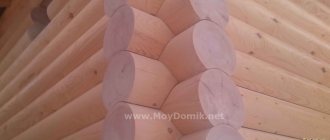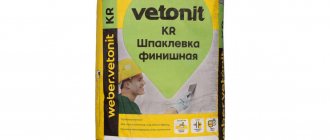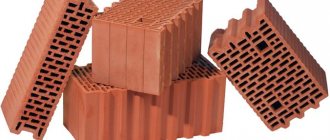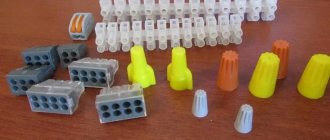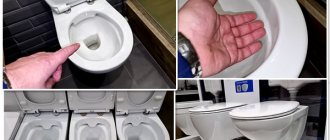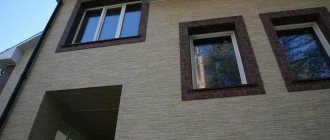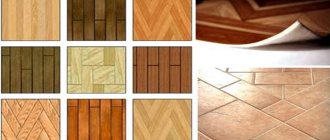Tongue-and-groove slabs are often used to create a partition in a room. They are distinguished by their ease of operation, weigh little, and last for many years. But for the durability of the structure, it is necessary to use high-quality adhesive seams so that they can withstand the load. For this purpose, a special glue for PGP is produced, but you need to choose it carefully, then the installation process will be easier and faster. The choice of glue will be discussed in detail below.
The main components from which it is made
Glue for tongue-and-groove slabs can create the necessary level of adhesion to the gypsum base, thanks to its constituent elements. The composition may vary slightly among different manufacturers, but the main elements most often used are the following:
- Gypsum, the main element necessary for adhesion strength, when contact with water occurs, crystals form on the layer, facilitating the reliable connection of two blocks to each other. The fixation rate can be improved by using smaller fractions of gypsum;
- Sand with tiny particles serves as a filling agent, helping to apply substances evenly over the surface, increases strength, and due to the presence of sand, the price of the product itself decreases;
- Modifiers play the role of a plastic agent, the service life of the layer becomes longer, and they create protection against biological formations.
Glue for tongue-and-groove slabs can create the necessary level of adhesion to the gypsum base, thanks to its constituent elements.
Fasteners for tongue-and-groove slabs
During the operation of walls and partitions made of PGP, it often becomes necessary to hang shelves, pictures and other objects on them. Since the blocks are low-density, special fastenings must be used. These include a dowel for a tongue-and-groove slab. The mounting process is as follows:
- Select a drill whose diameter corresponds to the size of the dowel.
- A hole of the required depth is made in the slab.
- A dowel is inserted and secured using special spacers.
- A screw is screwed into it.
The maximum load on such a mount is no more than 60 kg. If it is necessary for the partition to support heavier objects, through structures are used. Such fasteners have spacers that pass through the entire slab and are fixed on the opposite side. You can use anchor elements that can withstand weights of up to 200 kg.
The main purpose of glue for pgp
Tongue and groove adhesive can glue not only this material in order to obtain a variety of designs for their slabs. The scope of application of the product is wider; builders also use it for other materials.
You can glue plasterboard sheets to create a flat surface on the wall or ceiling. However, it is important to look at the permissibility of this action; manufacturers indicate on the packaging whether these materials can be bonded with the composition. The use of the product is limited to indoor work, because it is not moisture-resistant and will not be able to withstand natural influences.
You can glue plasterboard sheets to create a flat surface on the wall or ceiling.
Finishing
If the wall is built correctly, it will not need to be leveled. However, it is possible to plaster the GGP, but only a gypsum plaster mixture will do , and before starting work, the GGP should be treated with a primer so that the gypsum does not absorb moisture from the solution. And in the case of using plaster, even without a slab, you can paint, cover with wallpaper or ceramics.
The use of lime paints and paints on liquid glass is prohibited.
Items lighter than 30 kilograms (mirrors, lamps, decor) are attached to the PGP with dowels, heavy items , for example, wall cabinets, are attached with anchor bolts.
Which glue to choose
There are many adhesive mixtures on sale; dry types are most often chosen, but it is more convenient to work with foams. When choosing what to glue tongue-and-groove slabs onto, care should be taken that the product has high adhesion rates.
Special compositions are distinguished by the speed of complete hardening, which speeds up the process of constructing the structure, but this also requires a fast pace of work from the master. It is worth studying in advance on the packaging how long this process lasts.
If we talk about foams and mixtures, the former can be used immediately, you just need to shake the container, but they also dry out very quickly, which requires some skill from the master to cope quickly enough with the installation of partitions. But their cost is higher than mixtures, which must be properly prepared before use. Also, more dirt will be generated during operation.
To get a truly high-quality product, it is imperative to request a quality certificate from the seller.
Special compositions are distinguished by the speed of complete hardening, which speeds up the process of constructing the structure, but this also requires a fast pace of work from the master.
Additional Information:
When starting a renovation, we always want to choose the best and highest quality materials for our home, so that we can then enjoy coziness and comfort.
Therefore, by choosing knauf perlfix adhesive, we ensure reliable fastening of drywall sheets or insulation, and we will be sure that they will last for many years.
Knauf perlfix is a dry mixture (mounting mixture) made using certain polymer additives.
Knauf perlfix glue is chosen by professionals because it
- easy to use
- Has excellent soundproofing and thermal insulation qualities
- Made from environmentally friendly materials
Knauf perlfix is used only for work inside the building. This glue is not suitable for outdoor use.
Knauf perlfix 30kg is intended for gluing plasterboard sheets, as well as gypsum panels and other materials on various types of surfaces. It is worth noting that Perlfix Knauf glue is also suitable for working with uneven or already plastered surfaces. The only requirement is to observe the thermal regime and not work at temperatures below five degrees Celsius with a plus sign.
Knauf perlfix (the price of the product is indicated in the price list) is not picky, but before work it is still worth cleaning the work surface of various fats, dust, sand, paint and other elements. This will provide better grip for the knauf perlfix 30 kg.
Knauf Perlfix (the price is presented on the store’s website) is quite easy to prepare for use. knauf perlfix 30 kg is mixed in fifteen liters of water. After the mixture has completely dissolved, let it sit for two minutes, and then stir for five minutes. Next, Perlfix Knauf glue is infused for no more than five minutes and mixed again. That's it - the glue is ready to use!
Calculating consumption
When you are planning to create a structure from gypsum concrete, it is important to immediately prepare the materials necessary for the work. If there is not enough adhesive solution for the entire structure, the already erected part may suffer.
For this reason, it is better to make the calculation in advance; first, measure how many slabs will be used in order to understand what total area will be treated with an adhesive layer to connect the parts together. The manufacturer always prescribes the average glue consumption on the packaging; operation under optimal conditions is taken into account. But application tools, the experience of the technician, and layer thickness can affect the consumption.
To calculate approximately how much product you need to buy, the easiest way is to enter the resulting numbers in special cells in the online calculator, which companies usually have on their website. As a result, the number of kilograms of mixture that will be required is obtained, the calculation is made taking into account 5% for the reserve.
When you are planning to create a structure from gypsum concrete, it is important to immediately prepare the materials necessary for the work.
Installation technology
Required Tools
To install the PGP you will need:
- Level or rule
- Cement-sand mortar
- Gypsum based adhesive
- Staples or perforated corners
- Anchors, screws
- Felt seal or cork backing
- Gypsum mortar, primer, construction foam
- Spatula, hacksaw, screwdriver, rubber mallet.
Preparation
Before installing the slabs, you should bring them into the room and wait one day so that the material gets used to the temperature and climate and does not become deformed at the latest.
In the place where you are going to build, you need to clean and level the floor with cement-sand mortar .
You cannot attach the slabs to linoleum, parquet, laminate, paint or wallpaper.
At the point of contact of the slabs with the floor and walls, a felt seal or cork backing is glued.
Laying the first row
We cut off the ridge on one side of the lower slabs - this is the future foundation of the structure.
Then we apply glue to the seal and install the first slab to the wall, after inserting the staples into the grooves at the top and bottom. The first needs to be screwed to the wall, the second to the floor .
After installing the stove, you need to tap it with a rubber mallet.
The level of the entire structure depends on whether the first slab is installed level, which cannot be changed afterwards.
Each subsequent slab of the first row must be secured with a bracket to the floor . points with the floor and the previous slab are lubricated with glue . You should not use a lot of the substance; the excess will still be squeezed out by the stove. They must be removed immediately with a spatula . We check each slab with a level. And we install a new one only after the previous one has set. The glue is diluted in small portions because it sets quickly. The instrument must be washed immediately after use.
Construction of subsequent rows
For greater strength, the second row should start with 1/3 of the slab, which can be cut with a regular saw with a large tooth .
It is not recommended to use an angle grinder due to the abundance of gypsum dust.
Offset is also recommended when connecting slabs at an angle of 90 degrees: each new row should overlap the joint of the previous one. However, you can also use staples to create corners.
The distance between the last row of slabs and the ceiling should be no more than two centimeters. PGPs are attached to the ceiling with brackets using anchors, and the remaining space is filled with polyurethane foam.
Construction of doorways: Arch
If a doorway is planned in the wall being built, then its place is marked in advance on the floor vertically and horizontally, then two separated rows are simply erected. If the door width is no more than 0.8 meters, then the slabs can be placed directly on the door frame, but if the width is greater or there will be more than one row of PGP above the door, then a lintel must be installed in the structure, the cutouts under it must be filled with glue.
Preparation of mounting solution
The properties obtained from it as a result depend on the correct preparation of the solution. Be sure to follow the manufacturer's recommendations on this issue. High-quality products are accompanied by detailed instructions, where some points may be reflected.
In any case, take a clean container where the components will be mixed. First, water is poured, it should be at room temperature, after pouring it is left to sit for half an hour. Then, having measured the required amount of mixture per serving, add it to the water, slowly, then it will be easier to avoid the formation of lumps.
It is advisable to mix with a construction mixer or a drill with a mortar attachment. When you have a homogeneous mass, you can apply it to the surface.
It is advisable to mix with a construction mixer or a drill with a mortar attachment.
Usage
Average consumption of foam adhesive for silicate and gypsum boards: for products up to 130 mm wide - 1 strip, for larger ones - 2 strips for each joint. When working, you should follow some recommendations.
- The surface is carefully prepared and cleaned of dust.
- The container is shaken for 30 seconds and placed in a glue gun.
- 1 row of blocks is laid on a classic mortar.
- From the 2nd row, foam is applied. The cylinder is held with the bottom up; when applied, the nozzle of the gun should be 1 cm from the surface of the PGP. The optimal jet thickness is 20-25 mm.
- When used horizontally, the strips are not longer than 2 m.
- The leveling of the slabs is carried out within 2 minutes, position adjustment is possible by no more than 5 mm. If the curvature is greater, it is recommended to carry out the installation again, as well as when tearing off elements at the joints.
- After a break of more than 15 minutes, the gun nozzle is cleaned.
Installation is recommended to be performed in heated rooms or in warm, dry weather.
What can be replaced
The cost of special adhesives is not budgetary, for this reason many are looking for options to replace the product with a cheaper composition. And there is such an opportunity, for this you choose ordinary tile adhesive, to which you need to add PVA. The components are mixed thoroughly to obtain a finely dispersed mass that can reliably adhere to the GGP slabs.
You can also replace tile adhesive with cement mortar, this is an even more affordable option.
The components are mixed thoroughly to obtain a finely dispersed mass that can reliably adhere to the GGP slabs.
You can reliably glue tongue-and-groove slabs using special adhesives that have been developed for them. These adhesives create a reliable and durable adhesion that will not damage the gypsum material itself. But when choosing, it is important to pay attention to the instructions on the packaging, which indicate the possibility of operation. You should also purchase glue from trusted stores so that the composition is accompanied by a certificate of quality, and you do not have to use low-quality types. It is also possible to make a suitable composition yourself.
Types of adhesives
The adhesive is selected taking into account the operating conditions.
Adhesive foam for GGP comes in two types based on performance characteristics: regular and frost-resistant . The first is used in apartments and private houses where heating is available and the air temperature does not reach critical levels. Frost-resistant adhesive is used to create partitions in production facilities, warehouses, and industrial halls. It contains special protective components that allow the slabs to withstand frosts down to -15 degrees without losing their strength properties.
Depending on the characteristics of the room in which the renovation will take place, the glue may differ. There are two main types: based on gypsum and made from sand and quicklime . Construction mixtures are also classified according to moisture resistance .
They produce foam adhesive that can be used to connect tongue-and-groove slabs, bricks, and stones.
The most popular brands that produce glue for PGP are: Volma, Knauf, Bolars, IVSIL, ILLBRUCK.
Cost of glue for tongue-and-groove slabs
Choosing putty: three options for an important decision
How will the walls and ceilings look in the interior? The right choice of wallpaper and paint is not the only condition for a beautiful appearance. An equally important role is played by high-quality preparation of the surface on which the finishing coating is applied.
Each decorative coating has its own requirements for surface preparation. For example, for ceramic tiles it is enough to smooth out the most noticeable unevenness of the walls, but for thin wallpaper, decorative plaster, and especially paint, a perfectly smooth base is required. To achieve this result, special putty mixtures are used.
We will figure out what they are and how they differ together with KNAUF.
What types of putty are there?
Three types of putties are mainly used in construction: cement, gypsum and polymer. The classification is based on the type of binder, which, as you already understand, includes gypsum, cement or polymer compounds. The other two components in the putty are a filler, which is usually powdered marble, limestone or chalk, as well as modifying additives that improve and regulate the properties of the solution.
After mixing with water and mixing, the dry putty mixture acquires a paste-like consistency, and in this form is applied to the base in a thin layer, hiding unevenness. After drying, the composition hardens, firmly adhering to the surface.
How many pieces of foam block are in a cube?
| Block size, mm | volume, m3 | Quantity per 1 m3, pcs. |
| 600x200x200 | 0.024 | 41.7 |
| 600x250x200 | 0.03 | 33.3 |
| 600x300x200 | 0.036 | 27.8 |
| 600x350x200 | 0.042 | 23.8 |
| 600x375x200 | 0.045 | 22.2 |
| 600x400x200 | 0.048 | 20.8 |
| 600x450x200 | 0.054 | 18.5 |
| 600x500x200 | 0.06 | 16.7 |
| 600x250x250 | 0.0375 | 26.7 |
| 600x250x250 | 0.0375 | 26.7 |
| 600x300x250 | 0.045 | 22.2 |
| 600x350x250 | 0.0525 | 19.0 |
| 600x375x250 | 0.05625 | 17.8 |
| 600x400x250 | 0.06 | 16.7 |
| 600x450x250 | 0.0675 | 14.8 |
| 600x500x250 | 0.075 | 13.3 |
| Block size, mm | volume, m3 | Quantity per 1 m3, pcs. |
| 625x500x75 | 0.023 | 42.7 |
| 625x500x100 | 0.031 | 32.0 |
| 625x500x125 | 0.039 | 25.6 |
| 625x500x150 | 0.047 | 21.3 |
| 625x500x175 | 0.055 | 18.3 |
| 625x250x100 | 0.016 | 64.0 |
| 625x250x125 | 0.020 | 51.2 |
| 625x250x150 | 0.023 | 42.7 |
| 625x250x175 | 0.027 | 36.6 |
| 625x250x200 | 0.031 | 32.0 |
| 625x250x250 | 0.039 | 25.6 |
| 625x250x300 | 0.047 | 21.3 |
| 625x250x375 | 0.059 | 17.1 |
| 625x250x400 | 0.063 | 16.0 |
| 625x250x500 | 0.078 | 12.8 |
Low density
To begin with, it is worth noting that the low density of the GWP is not a disadvantage, but an advantage of this building material. Due to its low density, PGP has high thermal insulation performance. An 80 mm thermal insulation slab corresponds to a 400 mm concrete wall.
With GGP sound insulation the situation is not so clear, but it complies with regulatory requirements.
However, GGP slabs are fragile due to their low density. The fragility of the slab and its low density become clear when you start sawing the slabs during installation. They cut easier than wood.
What to glue drywall to
The process of installing gypsum plasterboard using glue can be carried out on smooth reinforced concrete walls or on partitions, the basis of which is tongue-and-groove blocks.
You can find out which tile adhesive is best to use during construction in this article.
Manufacturers and prices
The leading position in this case is occupied by the following brands:
- Perflix is a universal composition based on gypsum binder. You can purchase this Perlfix 30 kg composition for 330 rubles per bag.
- Silicone is an adhesive for installing plasterboard sheets, the use of which ensures rapid adhesion of the material to the base. This glue will cost you 450 rubles.
Adhesive for aerated concrete consumption per m3 and other characteristics of the material can be found in this article.
- Ceresit SM 11 is a mixture for plasterboard sheets. It is also recommended to use such an adhesive composition provided that the material is installed in a room with high humidity. You can buy glue for 560 rubles.
You can find out how long it takes tile adhesive to dry from this article.
- Knauf - assembly adhesive for drywall sheets. It has minimal consumption and quick coupling. The cost of the composition is 670 rubles.
Tile adhesive consumption per 1 m2 is calculated according to the scheme described in this article.
Consumption
As a rule, the consumption of a particular brand of glue is indicated on its packaging. This value is also influenced by the evenness of the wall:
- When installed on a flat surface, the consumption of the mixture per 1 m2 will be 0.5 kg of the mixture.
- When installed on a surface with defects, the consumption will be 3-5 kg.
- If installation is carried out on a surface with unevenness up to 20mm, then 4-6 kg of glue will be needed.
- When installing single partitions from slabs, 1.5-2 kg of adhesive mixture will be needed per 1 m2.
Which adhesive for ceramic tiles is best to choose and how to use it correctly can be found in this article.
Sealing seams
If you decide to install drywall using glue, then you should determine in advance the required amount of material, as well as the appropriate type, taking into account the main characteristics. To seal the seams between sheets of drywall, you must use a special putty. It has a special edge to obtain an even putty seam. If the installation of gypsum plasterboard is carried out in a room with high humidity, then it is worth using a special putty to seal the joints. Speaking specifically about the manufacturer, I most often use Fuhrenfüller putty to seal the seams between sheets of gypsum plasterboard.
This article describes the best adhesive that can be used for ceiling tiles.
The video explains which adhesive to choose for drywall:
Homemade from plaster
How to do it yourself? To prepare homemade glue, you need to take gypsum-based putty and add water to it. In this case, you can use both starting and finishing putty. The solution must be mixed using a special construction mixer. The resulting mixture should be of suitable thickness, since the solution should not be too liquid. After all, it will be simply impossible to carry out work on installing plasterboard sheets with such a hive.
You can see which glue to choose for use in the bathroom here by reading the article.
Now you can add PVA glue to the resulting mixture and mix again using a mixer. If you use 12-15 kg of putty, then you will need 1 kg of glue. It only takes a few minutes for the glue to sit, and then it can be spread over the surface of the wall.
What winter adhesive for gas silicate tiles can be used and applied, and most importantly, how to do it correctly, you can read here from the article.
It is applied pointwise, with slaps. When installing drywall on slopes, the number of points should be approximately 3-4. Be sure to apply the prepared composition to drywall. The advantage of homemade glue is that you can save on repairs, because such a composition will be much cheaper. But there is a drawback here. Ready-made formulations are designed for specific operating conditions. For example, if you use homemade glue to install drywall in the bathroom, you will not be able to get a good adhesion. Over time, the sheets will begin to fall off, and you will have to do the repair again.
You can use Prospector tile adhesive weighing 25 kg in the following cases described in this article.
The video shows the consumption of Perlfix plasterboard adhesive:
Material cost
You can buy dry mixture for 160-500 rubles. The price depends on the volume of the package and the number of components the material contains. The properties of the mixture also play a role: strength characteristics, elasticity, temperature conditions at which it is permissible to carry out work.
The higher quality the material, the higher its price. Often the consumption of such compounds is low and their service life is long. In addition, frost-resistant adhesives belong to a higher price category.
